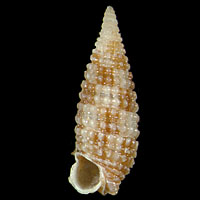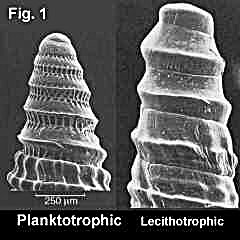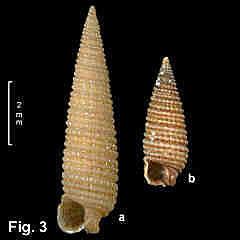|
< Previous family introduction |
|
|||||
|
|
Family Triphoridae Triphorids
|
|||||
|
Click to enlarge Click to enlarge Click to enlarge
|
The Triphoridae is a family of small molluscs, usually measuring 5-10 mm in length, most of which are sinistral (i.e. left handed) in coiling. The family is characterised by a distinctive radular morphology and internal anatomy, characters which define the family, rather than the direction of coiling. The family occurs world-wide in warm to frigid seas, from the intertidal to abyssal depths, although the greatest diversity is found in intertidal and shallow subtidal of tropical and temperate waters. All triphorids are sponge feeders, using their long, narrow proboscis to reach into the internal parts of a sponge. There have been three revisions of the NSW triphorid fauna. Charles Hedley, in 1903, dealt with the 15 most common species. Charles Laseron, in 1954, dealt with 27 species, some of which have since been placed into synonymy. Bruce Marshall, in 1983, published a substantial and impressive work which documented the entire southern Australian triphorid fauna of 68 species, including 34 from NSW. Using electron microscope imaging for shells and radulae he reorganised the generic classification based on protoconch type and sculpture plus radular characters. This present work is based almost entirely on Marshall's work. The triphorids have been regarded as difficult taxonomically, and it was not until the advent of the scanning electron microscope, allowing close examination and illustration of the protoconch and radula, that progress was made in classification. Hedley was aware of the significance of the protoconch and gave some fine figures, but had neither the equipment nor range of specimens to utilise it fully. Laseron also recognised the protoconch's importance and illustrated a few in his minimalist style. For the modern student of triphorids, if lacking an electron microscope, the task of identification is not much less difficult than for Hedley and Laseron. The protoconch and radula provide the basis of identification, but specimens with a good protoconch are uncommon. In the absence of these characters identification falls back on sculpture, shell morphology and colour. Fortunately some species have distinctive colour patterns, and for the remainder close examination of shell sculpture is usually sufficient for identification. Of the 34 species recorded from NSW by Marshall, several are known from only one or two specimens, and about half are known from less than 20 specimens. Of the remainder, 10 species could be classified as common or moderately common; most of these are collected in shell grit as beach washup, but two species occur entirely subtidally, down to around 500 m. Most of the species found in NSW have a southern Australian distribution, typically from NSW to south-western WA, but a few are restricted to NSW. Another small group is found throughout the tropical Indo-West Pacific region, with the distribution reaching into northern NSW, and in a few cases, as far south as Sydney. Family References Hedley, C. 1903 The Triphoridae of New South Wales. pp. 606-618 in. Studies on Australian Mollusca. Part VII. Proceedings of the Linnean Society of New South Wales 27: 596-619 Laseron, C. 1954. Revision of the New South Wales Triphoridae. Records of the Australian Museum 23(4): 139-158, text figs 1-30 Marshall, B.A. 1983. A revision of the Recent Triphoridae of southern Australia. Records of the Australian Museum Supplement 2: 119 pp., 3 figs, 30 pls Coverage All of the named species from NSW are detailed here. Identification Notes Direction of Coiling: Most triphorids are sinistral. The exceptions in NSW are Metaxia protolineata and Seilarex turritelliformis, which look very much like turritellids. Protoconch: The protoconch of triphorids may be either lecithotrophic or planktotrophic (Fig. 1). Lecithotrophic protoconchs are produced by larvae which are only briefly planktonic before settlement and metamorphosis. They have only a few whorls with simple sculpture and tend to have an indistinct junction with the teleoconch. Planktotrophic protoconchs are associated with larvae which hatched as free-swimming veligers and spent a long period feeding and growing in the plankton. In the triphorids they may be up to six whorls and elaborately sculptured. Protoconch type and sculpture are critical in classification of the triphorids, but unfortunately protoconchs are usually not present or not well preserved in either live collected or beach specimens. Sculpture: Triphorids have spiral cords and axial costae, usually with nodules at the intersections (Fig. 2). In most species there are 4 spiral cords on each whorl, named spiral 1 to spiral 4. Spiral 4 is usually partly or completely covered by the next whorl, and so only fully visible on the last whorl. Marshall (1983) generally considered the 4th spiral to be visible on most spire whorls, but it requires an electron microscope to see it clearly. The spiral ribs do not all commence at the same stage of shell growth. It is most common for spirals 1 and 3 to start immediately after the protoconch, and for spiral 2 to commence a few whorls later as a weak thread and increase in strength over successive whorls. Thus the sculpture on the last whorl of a shell of for example, 5 whorls, will be different to one of 10 whorls. On the other hand, in some species all spirals commence together immediately after the protoconch, and remain of similar size throughout growth Size and number of whorls: The number of whorls present when a shell reaches maturity, recognised by expansion of the outer lip of the aperture, is widely variable within a species in this family. Thus the shell length at maturity is also variable, and the outline of the spire may vary considerably in convexity (Fig. 3). Colour: In some species, about one-third of those in NSW, shell colour is distinctive and assists with identification.
Most common species in NSW
Shells with a distinctive colour pattern
|
|||||



